Search Thermo Fisher Scientific
Thermo Scientific Chemicals
4-Hydroxy-3,5-dimethoxycinnamic acid, 98%
CAS: 530-59-6 | C11H12O5 | 224.212 g/mol
Catalog number ALFA15676.06
View Price:Sign InSign in to see your account pricing. Need an account? Register with us today.
Quantity:
5 g
Specifications
Chemical Name or Material4-Hydroxy-3,5-dimethoxycinnamic acid
CAS530-59-6
Health Hazard 1H315-H319-H335
Health Hazard 2GHS H Statement
H315-H319-H335
Causes skin irritation.
Causes serious eye irritation.
May cause respiratory irritation.
H315-H319-H335
Causes skin irritation.
Causes serious eye irritation.
May cause respiratory irritation.
Health Hazard 3P261-P264b-P271-P280-P302+P352-P304+P340-P305+P351+P338-P312-P332+P313-P362-P501c
View more
4-Hydroxy-3,5-dimethoxycinnamic acid is a commonly used matrix in MALDI mass spectrometry. It is a useful matrix for a wide variety of peptides and proteins. It serves well as a matrix for MALDI due to its ability to absorb laser radiation and to also donate protons (H+) to the analyte of interest.
This Thermo Scientific Chemicals brand product was originally part of the Alfa Aesar product portfolio. Some documentation and label information may refer to the legacy brand. The original Alfa Aesar product / item code or SKU reference has not changed as a part of the brand transition to Thermo Scientific Chemicals.
Applications
4-Hydroxy-3,5-dimethoxycinnamic acid is a commonly used matrix in MALDI mass spectrometry. It is a useful matrix for a wide variety of peptides and proteins. It serves well as a matrix for MALDI due to its ability to absorb laser radiation and to also donate protons (H+) to the analyte of interest.
Solubility
Soluble in methanol, ethanol and dimethyl sulfoxide.
Notes
Store in cool dry place in tightly closed container. With good ventilation. Store away from oxidizing agent.
4-Hydroxy-3,5-dimethoxycinnamic acid is a commonly used matrix in MALDI mass spectrometry. It is a useful matrix for a wide variety of peptides and proteins. It serves well as a matrix for MALDI due to its ability to absorb laser radiation and to also donate protons (H+) to the analyte of interest.
Solubility
Soluble in methanol, ethanol and dimethyl sulfoxide.
Notes
Store in cool dry place in tightly closed container. With good ventilation. Store away from oxidizing agent.
RUO – Research Use Only
General References:
- Ronald C. Beavis; and Brian T. Chait. Matrix-assisted laser-desorption mass spectrometry using 355 nm radiation. Rapid Communications in Mass Spectrometry. 1989, 3 (12), 436-439.
- Ronald C. Beavis; and Brian T. Chait. Cinnamic acid derivatives as matrices for ultraviolet laser desorption mass spectrometry of proteins. Rapid Communications in Mass Spectrometry. 1989, 3 (12), 432-435.



